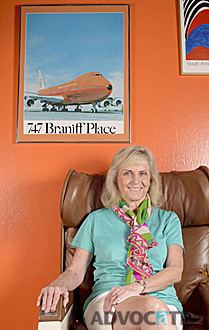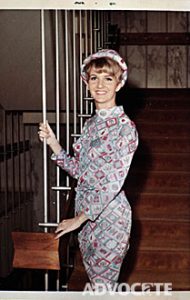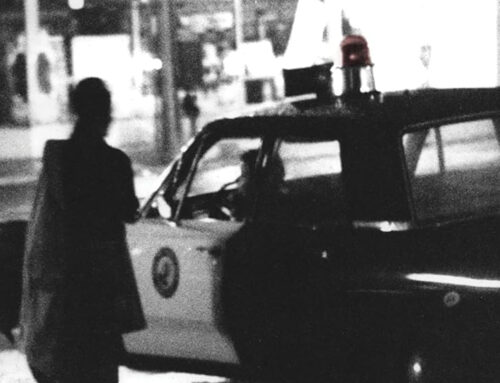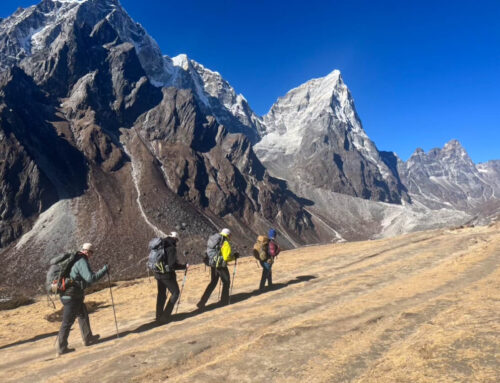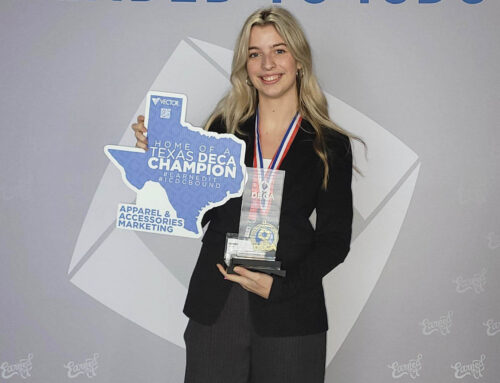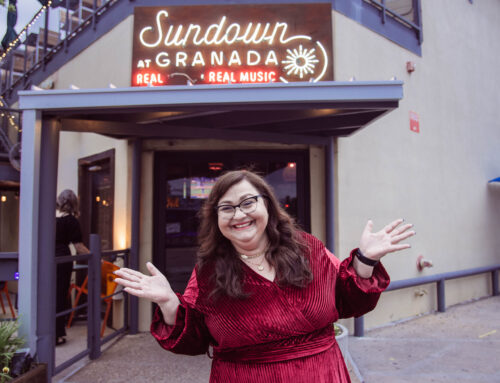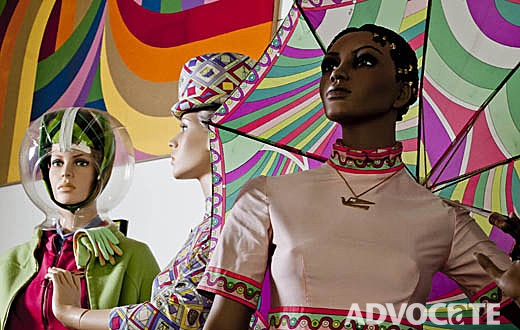
The Braniff exhibit at the Frontiers of Flight Museum attracts both former staffers and fashion aficionados.
Remembering a unique era in air travel, when it was all glitz, glamour and questionable practices
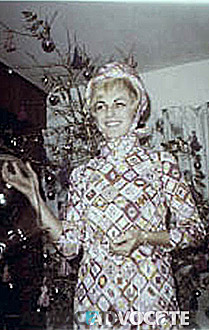
In the 1960s, Miki Snell worked in a bright Emilio Pucci uniform. At lower right, Snell sports a scarf from a Braniff uniform.
Flying in the 1950s and ’60s was all luxury, style and class. Pilots greeted pristinely dressed passengers as they boarded. Beautiful hostesses donned fashion-forward mini dresses and high-heeled boots, served up cocktails and chef-prepared lunches, and when one of them delivered the seat belt instructions, people actually listened.
Back then, women in their late teens and 20s clamored for a flight attendant job, typically available to about one in a hundred applicants.
In 1965, Dallas-based Braniff hired White Rock area resident Miki Snell on the spot — she says she thinks they were trying to fill a class and her timing was right.
At the time, airlines looked for girls to fit a certain mold, she says.
Snell and her contemporaries weren’t called flight attendants, as they are under today’s gender-neutral standards, but “hostesses.” On other airlines, they often were “stewardesses.” In height, they were 5 feet 2 inches to 5 feet 7 inches, and they weighed no more than 135 pounds. Married girls needed not apply. Each woman teased her hair into a puffy do, wore Valentine-red lipstick and nail polish, and squeezed into a girdle that fit so tight that, “by the end of the day, you had a mesh pattern on your flesh,” she says.
Though sex appeal was essential, preparation for the flight crew was intense. Before taking off, Snell attended a five-week training school at what is now the maintenance center at Love Field.
“We had to learn about the planes, their configurations and food service, but the biggest thing was emergency training — learning about the equipment on the aircraft and what to do in medical emergencies. It was pretty comprehensive.”
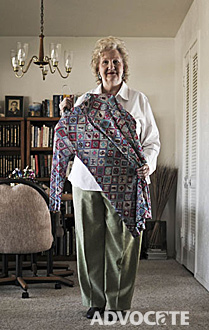
Hunley recalls fondly how her Braniff job exposed her to travel, cuisine, culture and fashion. Photo by Danny Fulgencio
Retired Braniff pilot Don Maynard still has his late wife’s faded hostess-training manual (when they married, she had to quit).
“I think it might have been a little tougher than they thought it was going to be,” he says, holding up the thick-ish typewritten booklet. “Though you should have seen our [pilot’s] manual!”
Flying is in Maynard’s blood. His father was a New Orelans-based pilot, and Maynard flew solo the first time when he was 16. He joined Braniff in 1951.
“Aviation was glamorous — people wore suits and ties to go to the airport,” he recalls.
There were plenty of practices that wouldn’t fly today, he says, describing the hostesses’ pre-flight weighing-in ritual: “Before a flight, they got on a scale. And they got pinched. Sometimes, if they weighed too much, they were sent home.”
The pinch, Snell says, was to ensure the girdle was in place.
Lake Highlands’ Sherry Hunley, also a Braniff hostess in the late 1960s, recalls some of the tricks used to fool the scale.
“Some would cheat. Putting a pencil under the scale was a popular way,” she says.
The high-fashion atmosphere, while it could be uncomfortable, was simultaneously cool, Snell says.
“It was all chic, trendy and fun. We got a new uniform every couple of years, and even the planes were painted bright like jelly beans.”
Hunley remembers when the Braniff look really took off. An advertising executive named Mary Wells spearheaded the “End of the Plain Plane” campaign in November 1965.
“The next thing you know, everything right down to the swizzle sticks changed,” Hunley says. “We had the look, and it put us on the map.”
The campaign even called for in-flight wardrobe changes that came to be nicknamed “The Air Strip.”
Hunley describes one uniform: “patterned tights and a jersey top with these wild prints, and bowler hats with the same print.”
Some of the hostesses’ accessories included stylish serving aprons worn during meal service, a miniskirt-length reversible hot pink and navy overcoat, and the famous space bubble hat, designed to shield bouffant hairdos from the atmospheric elements.
“Those were quite impractical,” Hunley says. “Mostly they were for photo ops.”
Of course, when the Southwest stewardesses, also based in Dallas, started wearing hot pants and go-go boots, Hunley says, “we got hot pants, too. There was a little bit of competition.”
At the Frontiers of Flight Museum, which houses hundreds of flight-related artifacts and replicas dating back to World War II, the upper-level Braniff exhibit is one of the most popular, says Jess Hall, the museum’s development director.
Several Braniff hostess uniforms — runway-worthy dresses, pantsuits, smocks and accessories designed by Emilio Pucci — serve as the centerpiece, and the gallery includes Braniff Barbie dolls, matches, playing cards and other memorabilia. Members of the Clipped Bs, an organization of former Braniff hostesses who stay in touch today, donated many of the pieces.
Flying around the globe, especially for young women such as Hunley, was more than just a job — it was educational and magical, she says. It opened the door to new worlds. “I grew up in Lake Highlands, at the time across the street from a farm,” Hunley says. “I had never even flown in an airplane before I got the job.”
By age 20, Hunley had a teaching degree and an offer from Richardson ISD, but she couldn’t resist the allure of the airlines. She really wanted to work for American Airlines at first.
“They had these red, white and blue uniforms and fishnet stockings. I interviewed with them and never heard back.”
Later, she says, she learned that her dad had intercepted the call. He wanted her to be a teacher.
With Braniff, she flew to California, London, Tokyo, the Philippines and Vietnam, for starters.
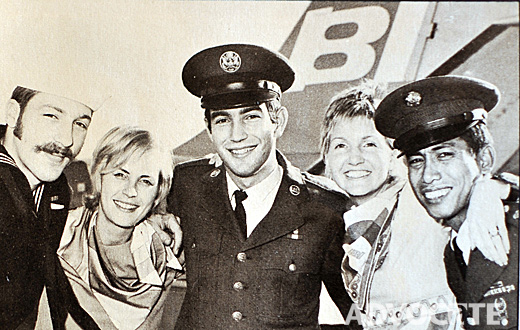
Lake Highlands’ Sherry Hunley (woman on right) and a fellow flight attendant welcome home Vietnam war veterans
“I couldn’t believe they were paying me for this. I had to pinch myself. Here I still had hay in my hair, and now I’m flying around the world. It was just incredible at that age.
“Onboard, we knew the passengers by name and knew what they drank. We didn’t have those carts, but used trays. Braniff prided itself on getting every passenger a drink before takeoff. Because of regulations, we had to pick up the drinks before takeoff, too, so sometimes you’d have men drinking a big martini or even two before takeoff. We had to be fast and organized.”
She recalls elaborate meals — chateaubriand carved in front of the passenger, eggs benedict, crepes suzette, even caviar en route to London.
“On a plane just recently, I see people pulling out a credit card for a small, bad snack, and I think, ‘It’s not like the old days!’” Indeed, things have changed and security has intensified. Pilot Maynard recalls a time when he stood at the door and greeted passengers as they boarded the plane.
“Now they lock us up tight inside the cockpit. Where once kids used to be able to visit the cockpits, now there is virtually no interaction between pilots and passengers.”
Maynard is the first to admit: He and the other pilots loved the pretty hostesses. As a young co-pilot, when he first saw Jeanne Toews walking up the tarmac in her sexy Pucci uniform, he said to his pilot, “I’m going to marry her.” In May 1957, he did.
With the women’s liberation movement came shifting standards for flight attendants. Maynard stops short of disapproving of the changes.
“Now you might get a hairy-legged guy rather than a pretty young lady coming to the cockpit. I’ll just leave it at that,” he says with a grin.
The loss of luxury started with deregulation in the late ’70s, Maynard says. “Fare wars led to pay cuts and cuts all over.”
Even during the most dazzling era, air travel wasn’t entirely glamorous.
Hunley, for example, recalls training at a defunct shoe warehouse in Fairfield, Texas. Snell says she once spent 10 hours in an airport ladies room while waiting for her assigned flight, just so she could take off her heels. She also was onboard a plane during a bomb scare, after which she and her crew underwent questioning by the FBI.
Despite Braniff’s sometimes-borderline misogynistic regulations and an eventual bankruptcy, which disrupted the lives and livelihood of Hunley, Maynard and many others, Hunley remembers the era fondly.
“It changed my life and I learned so much — more than I would have learned spending those years in college,” she says.
Airline employees — many of whom live in Dallas because it was home to Southwest, Braniff, American and two major airports — tend to stay in touch even long after retirement.
Maynard, for example, is on the board of an organization of former Braniff pilots, and he maintains close bonds with many of his fellow aviators. Hunley too says that, in flight, she made lifelong pals.
“I still have friends all over the country from the flying days,” she says. “Braniff was like a big family.”

